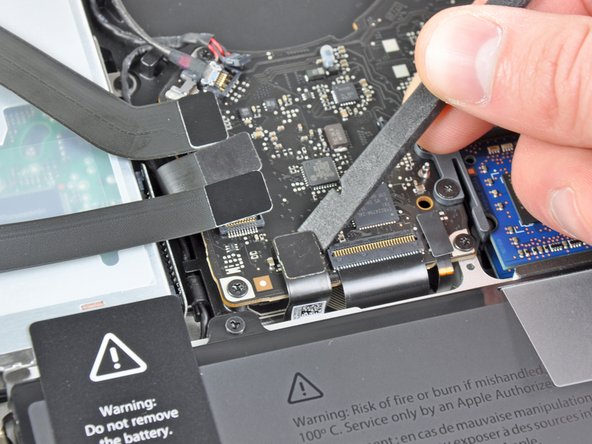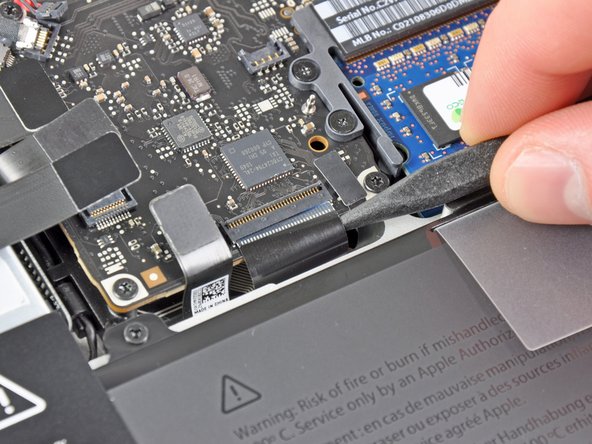Introduzione
La pasta termica OEM del tuo MacBook Pro lo fa rallentare parecchio quando si scalda? Segui questa guida per rimuovere il dissipatore e applicare della nuova pasta termica.
Cosa ti serve
-
-
Rimuovi le dieci viti seguenti:
-
Tre viti con testa a croce Phillips #00 da 14,4 mm
-
Tre viti con testa a croce Phillips #00 da 3,5 mm
-
Quattro viti con testa a croce Phillips #00 da 3,5 mm con spallamento
-
-
-
Usa l'estremità di uno spudger per rimuovere il connettore della batteria dal suo zoccolo sulla scheda logica.
-
-
-
Usa il bordo di uno spudger per scollegare il connettore della ventola dalla sua presa sollevandolo dalla scheda madre.
-
-
-
-
Usa la punta di uno spudger per tirare il cavo dell'altoparlante/subwoofer destro fuori dalla sporgenza di bloccaggio in plastica integrata nella scocca superiore.
-
Tira il cavo dello speaker destro verso l'alto per scollegarlo dalla sua presa sulla scheda madre.
-
-
-
Stando attenti ai diversi connettori vicino ai bordi, solleva la scheda madre dal bordo vicino al lettore CD.
-
Senza piegare la scheda, rimuovila dalla scocca superiore, stando attento al cavo flessibile della scheda di alimentazione che potrebbe impigliarsi nella scocca superiore.
-
Rimuovi la scheda madre.
-
-
-
Svita le tre viti a croce Phillips #1 da 8,4 mm che fissano il dissipatore alla scheda madre.
-
Per rimontare il dispositivo, segui le istruzioni in ordine inverso.
Per rimontare il dispositivo, segui le istruzioni in ordine inverso.
Annulla: non ho completato questa guida.
Altre 98 persone hanno completato questa guida.
Un ringraziamento speciale a questi traduttori:
100%
Questi traduttori ci stanno aiutando ad aggiustare il mondo! Vuoi partecipare?
Inizia a tradurre ›
17 Commenti
Awesome guide, I was able to complete the whole job (very slowly and carefully) in an hour start to finish. I am not an expert, I am just your average, everyday DIYer. I'm actually a medical student with an interest in engineering and "tinkering" looking to save money however I can. I would HIGHLY recommend this to every one of my friends (and I may even do this for some people). My keyboard doesn't get warm anymore, and my fan stays quieter doing more things. I'm now running 40-45 degree temps instead of 70-85 temps. Incredible. Like others on the internet, my computer had a TON of paste on it that was all over the CPU. I feel better now that I know how my computer was put together (by me). Good luck!
I also reapplied thermal paste under the heatsink on my early 2011 Macbook Pro. Temps are on average much lower, now my cpu almost never spikes above 70 C. I used the mac application Hardware Monitor to check temps in real time before and after. Previously doing pretty much anything on my MBP would cause the fan to spin at its max rpm and the computer was almost always hot to the touch. Now it's silent (also swapped the hdd for an ssd) and the fans almost never turn on at all!
I followed the guide after my MBP began showing extreme CPU temps like 95-98 C.
I removed all the dry paste that was left on top of the CPU, and replaced it with a brand new paste.
But it didn't work. I'm still getting these high temps. I reopened my computer and placed even more paste. But it's not cutting it.
I'll try a new cooler. Maybe that helps... though. I'll comment here if it does.
Less is better, you want a very thin (think see through silk thin) coating between the CPU and the Cooler otherwise it acts as an insulator and causes more heat not less. just enough to make sure that no air is between the two.
Awesome guide Ifix it rules! Loved the step by step format. Im not a big fan of videos. The zoomed pictures saved my life as reference. Perfect!



































